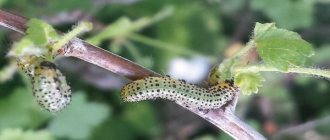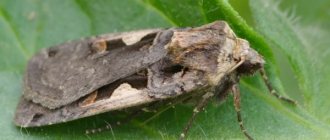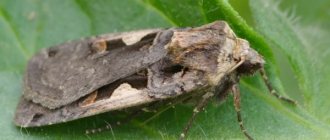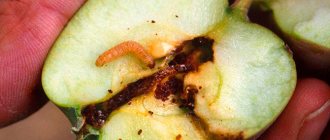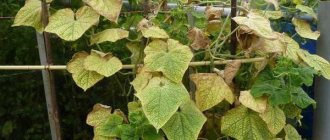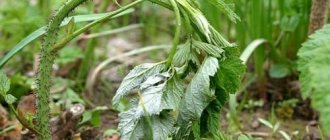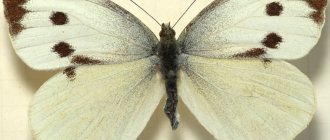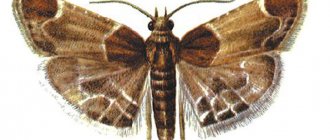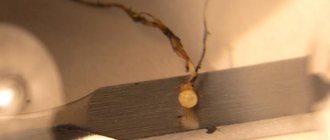One of the common pests of coniferous forests is the pine sawfly. Hymenoptera insect larvae spoil various types of pine trees, and during massive outbreaks they destroy some of the trees. The pest is found everywhere from Europe to the Far East, and has taken root in the northern part of the USA. Regular population monitoring and comprehensive control measures help prevent the spread of sawflies.
How to get rid of pine sawfly: main types and control measures
It’s pleasant to walk through a pine forest - tall, slender trunks of pine trees rise up, green crowns rustle soothingly above, the air is filled with the smell of pine needles. The pine forest supplies people with high-quality wood and resin; it holds the soil together with its roots and increases the humidity around it, and its air is healing. The pine forest pacifies, brings peace and joy to the heart. By planting several pines in your dacha, you can create a small coniferous oasis for relaxation and peace, and it is very unpleasant when your pines are under threat. In addition to fire and various diseases, one of the main threats is the invasion of insect pests. Such pine pests are pine sawflies.
Description and types
Pine sawflies are insects belonging to the order Hymenoptera. Their range covers all areas where pine and similar coniferous trees grow. It is one of the most dangerous pests of pine forests.
Adult males and females resemble flies or wasps, they differ from each other in appearance, and usually do not feed at all or feed on nectar. The main damage is caused by larvae that look like caterpillars, which is why they are often called false caterpillars.
Among pine sawflies, the most common pests of our forests are the common and red pine sawfly; these species are similar in many ways.
Ordinary
Adults: Female - round body, color - from red to light yellow, black head, black markings on the body, reaches a length of 10 mm. The male is smaller than the female, the body is thinner, the color is completely black, the antennae are fluffy.
They like to settle in young pine forests, but are found in a variety of pine and mixed forests.
The eggs are oval, greenish, up to 1.5 mm, laid in last year's needles, covered with greenish-brown foam on top.
Larvae are the main pest. Color - from pale yellow to greenish, on the body there are black spots above each leg, grow up to 2.8 cm. They are held in nests, move and move synchronously.
The pupa is in a hard cylindrical cocoon of gray, brown or brown color, about 1 cm.
Ginger
Adults: Female - round body, red in color, reaches a length of 9 mm. The male is smaller, up to 7 mm, the body is thinner, the color is completely black, the antennae are feathery. Habitats are similar to the previous species.
The eggs are oval, yellowish-white.
The larvae are gray in color, the head is black, there is a light stripe along the back with a border on the sides, on the sides there is a wide, black stripe with a light border, they grow up to 2.5 cm. The behavior is similar to that of an ordinary sawfly.
The pupa is in a hard cylindrical cocoon of yellow-golden color. Located in the forest floor until the emergence period.
Spruce
This is a small ( 5-6 mm in length ) almost completely black insect with long, thin antennae, where the yellow parts of the body are the mouthparts, abdomen and frontal veins of the wings. Can be found from April to June.
Light green, almost pine-like, black-eyed larvae have 3 pairs of sharp dark legs at the beginning of the body and 7 pairs of false legs in the rest. They grow up to 1-1.5 cm in length . They actively feed on young needles from May to June, after which they seek refuge in the forest floor for pupation.
These insects seriously damage many types of coniferous trees, causing their growth to be inhibited.
To prevent serious outbreaks of sawfly reproduction, pine needles need to be sprayed with special preparations against young larvae. It is useful to dig up the so-called tree trunk circles to detect and eliminate nests of larvae.
Life cycle features
The common pine sawfly grows one or two generations per year, depending on the latitude of its habitat, the emergence of the first occurs in late spring–early summer, the emergence of the second in mid-to-late summer.
The female lays from 8 to 35 eggs at a time in cuts she makes on the needles, and covers them with a foamy coating for preservation. The needles, as a rule, are last year's, most often on the tops of the crowns. Then, after about 20 days, the eggs develop, and larvae emerge from them in 3–4 days.
The larvae stay in large groups, eat off and grow. Depending on the daily temperature, the development period of the larvae ranges from 25 days at +26°C to two months at +10°C. Having finished feeding, the larvae form a cocoon and pupate.
The first generation attaches itself to the crown, development lasts 6–12 days, the second generation moves to the forest floor, where it overwinters. Adults emerge from pupae usually around noon.
The red pine sawfly grows only one generation per year; emergence occurs in late summer–early autumn. Females lay eggs on needles in increments of about 1.5 mm; on average, up to 100 eggs are produced on a shoot, and in outbreaks of reproduction up to 10,000 on one tree.
Egg development ends in spring. The larvae behave similarly to ordinary sawflies. The duration of the development period depends on the temperature, from 30 days at +27°C to one and a half months at +13°C. The larvae in the cocoon lie in the needles of the forest floor until August, then pupate.
They overwinter both as larvae in a cocoon and as eggs.
Silkworm
This is a terribly voracious pest. The silkworm caterpillar is active at night. His butterflies are completely harmless, except for the fact that they lay eggs. But their larva, the silkworm caterpillar, is a real monster that prefers the foliage of apple, linden, and birch trees. Hiding from the sun, the caterpillars crawl to the ground during the day. The genus of silkworms includes several species:
The gypsy grows up to 6 cm in length, it is densely covered with dark gray hairs, it has five pairs of blue warts in front and six red ones in the back. These caterpillars are the most dangerous. More than 300 species of different plants can serve as their food. The different sizes of the male and female gave the pest its name. This pest lays eggs in the butt part and can withstand temperatures down to -60 °C. The butterfly begins to fly in July.
- The mulberry prefers the foliage of the mulberry tree. It spins a cocoon where the caterpillar becomes a butterfly. The finest cocoon thread is used to make expensive silk fabric. The caterpillars are dark brown in color, growing up to 8 cm, and lighten to white with gray spots. Their butterflies are large, dirty white, with a thick abdomen and short antennae.
- The nun is a black and white butterfly with jagged antennae. Its caterpillar grows up to 6 cm, has 16 legs and thick hair. It feeds mainly on needles, but will not refuse the foliage of birch, oak, apple and beech.
- The Siberian silkworm (cocoon moth) is considered very dangerous. Its butterfly is large, light brown to black in color. Distributed from the Urals to Primorye. The female lays eggs on needles, branches and trunks. The caterpillars are up to 7 cm in length, feed on pine needles and overwinter under the cover of foliage and pine needles on the ground.
Damage caused
Pine sawfly larvae eat the needles. During mass reproduction, the branches are densely dotted with larvae, one or two per needle. Young larvae eat the edges of the needles, leaving only the central vein and the top, while the needles dry out, curl and turn yellow.
Article on the topic: Bud mite on currants: control measures, remedies, preparations
The older larvae eat the needles completely, to the base. During growth, one larva eats from 30 to 40 needles, both young and old. As a result, the tops of the pine trees dry out, the trees slow down and become weaker, which leads to diseases and the infestation of tree trunk pests.
Most often, young, up to 30 years old, plantings on hills, in warm, dry weather in late spring and early summer, are massively affected.
Nutrition
Sawfly larvae actively consume needles. At the beginning of spring it is old needles. Then the pests switch to young shoots, damaging not only the needles themselves, but also thin branches.
There are mainly two types of pines affected: Banks and Scots. They are particularly gluttonous in dry and warm weather.
The most innovative method of controlling flies and mosquitoes is the electric fly swatter. Rat ticks are carriers of such dangerous diseases as typhus, tsutsugamushi fever, and various types of rickettsial diseases. Read more about these parasites here.
The moth caterpillar is hairy and has a bright color. Read the article at the link to see what this insect eats.
Control measures
When suitable conditions arise, an explosive increase in the number of pests occurs. The fight against pine sawfly in the garden and especially in the forest is quite problematic; mechanical, chemical or biological methods can be used for it.
In the forest
The degree of infestation of trees is determined visually by the number of larvae crawling along the trunks, by their waste products and by the number of cocoons in the forest litter.
Mechanical measures: In the forest, manual removal of larvae from branches is not feasible. The only thing that can be used is to create trap rings on the trunks that prevent the larvae from descending and crawling from tree to tree.
The rings can be sticky or killing when the trunk is wrapped in cloth containing the appropriate product.
Chemical measures: When large populations of pine sawfly are detected, as well as when there is significant damage to tree needles, it is rational to combat it with chemical insecticides.
Trees are treated with systemic preparations that combine internal contact actions and kill both when they come into contact with the pest and through food. It is advisable to use several different insecticides when processing.
The following drugs are recommended:
- Aktara - active ingredient - thiamethoxam;
- Kreotsid Pro, Arrivo - cypermethrin;
- Vermitec - abamectin;
- Fufanon, Novaktion - malathion;
- Inta-Vir, Actellik - pirimiphos-methyl.
Biological measures: In the fight against sawfly, you can use herbal infusions or, which is more rational in the forest, preparations based on the actions of microorganisms that are dangerous to the pest.
The pine sawfly is well affected by the following biological preparations: Fitoverm, Lepidocid, Bitoxibacillin, Lepidobactocid.
In the garden plot
If a pine sawfly appears in a dacha, the same control measures can be applied to it as in the forest, but in proportion to the need. In addition, methods are added that are not applicable in the forest due to the scale of the impact.
Mechanical: The simplest thing is to manually collect the larvae from the branches and trunk or knock them off with a strong stream of water. The larvae must be removed from the ground, and the soil under the trees must be dug up.
For the purpose of prevention and pest control, it is recommended to plant tomatoes near pine trees; their smell repels the sawfly. For the same purpose, you can attract natural enemies of the sawfly, such as ants and insectivorous birds, by placing feeders or luring them with sugar.
Chemical methods are no different from those used in the forest. You can treat trees with solutions of karbofos or chlorophos (10 g per 10 liters of water).
How to deal with sawfly
Sawfly remedies (preparations)
In order to save the plant from the sawfly, chemicals, or rather insecticides, are often used. The most effective insecticidal agents:
- Karbofos . This is a contact insecticide-acaricide with a wide spectrum of action. It is included in most drugs.
- Benzophosphate . This organophosphorus insecticide-acaricide has an intestinal-contact effect.
- Metaphos . This is a contact insecticidal preparation with broad-spectrum acaricidal properties. Its active substance is parathion methide.
- Chlorophos . This insecticide and pesticide of contact-intestinal action are widely used in the fight against harmful insects of various plants.
- Phosphamide . This systemic and contact-acting acaricide and insecticide is absolutely harmless to warm-blooded animals.
- Arrivo . This broad-spectrum insecticidal preparation is characterized by contact and intestinal action. Cypermethrin is its main active substance.
- Virin-Diprion . This viral remedy is used to exterminate pests on all plants, including trees.
- Aktara . This insecticidal agent of the neonicotinoid group is distinguished by its high effectiveness against most pests.
- Karate . This enteric-contact pyrethroid insecto-acaricide is highly effective even with low product consumption. Its active substance is lambda-cyhalothrin.
- Confidor . This insecticidal agent of systemic contact-intestinal action is used in the fight against gnawing and sucking pests. The active substance is imidacloprid.
- Mospilan . A systemic insecticidal agent characterized by contact and intestinal action.
- Kinmiks . A broad-spectrum pyrethroid insecticidal preparation that is highly effective.
- Decis . This is a garden contact-intestinal insecticidal preparation that blocks the digestive system of the pest. The active substance is deltamethrin.
In addition to these means, many others are used in the fight against sawflies.
Preventive measures
In order to protect your site from sawflies, it is recommended not to forget about preventive measures:
- In the trunk circles of shrubs and trees, the soil surface must be systematically dug up and loosened. Thanks to this, quite a lot of sawfly larvae and pupae will die.
- Dried and diseased trees should not be in the garden, as pupated pests prefer to overwinter in them.
- Those ovaries that are injured by the beetle should be cut off and destroyed by fire or buried in the soil to a depth of at least half a meter.
- At the beginning of spring, it is recommended to wear hunting belts on tree trunks. You can also use pheromone traps to combat sawflies.
Folk remedies
You can fight the sawfly with various folk remedies:
- At the initial stage of development, in the fight against this pest, you can use an infusion of the herb aconite, which must be collected during flowering. To prepare the infusion, you need to combine 1 bucket of water and 1 kilogram of herb, and 30 milligrams of alkali are also poured into the mixture. The product will be ready after 2 days. Before you start spraying the plants, pour 40 to 50 grams of liquid soap into the product.
- In order to get rid of pest larvae, use chamomile infusion. To do this, pour a kilogram of crushed leaves and chamomile flowers into a bucket of water, the temperature of which should be from 60 to 70 degrees (the grass is collected during flowering). The infusion will be ready after 12 hours, then it is filtered and diluted with water 1:1. You need to add 40 grams of liquid soap to the bucket of the prepared solution.
- 1.2 kg of fresh wormwood herb is dried and then mixed with 1 bucket of water. The infusion will be ready in 3 days. Then you need to pour 50 to 100 grams of baking soda into the strained product.
- 10 liters of water are combined with two kilograms of pine needles. The mixture is stirred every day for one week, during which time it should be kept in a dark place. The strained infusion should be diluted with water in a ratio of 1:3 or 1:5.
- One bucket of water is combined with 70 grams of soda ash and 20 grams of liquid soap.
- A bucket of hot water is mixed with three kilograms of sifted wood ash. The infusion will be ready in 2 days; it is filtered through a small sieve or gauze. Before processing, 40 grams of liquid soap are poured into it.
- One bucket of water is combined with a kilogram of fresh tansy. The mixture is boiled for two hours and waited until it cools down. 40 grams of liquid soap are poured into the strained product.
It is recommended to use folk remedies only when there are very few sawflies. But most summer residents use them only as a means of prevention.
Prevention
The pine sawfly loves warm, dry, open areas of the forest. High humidity leads to diseases and death of pests. In addition, in nature it has many natural enemies: birds, ants, predatory and parasitic insects, and a lot of pathogenic bacteria.
All this is used in forests for prevention.
When creating plantings, it is necessary to make them mixed, interspersing pine trees with sections of deciduous trees, evenly planted, without breaks, clearings or bald spots. The edges should be made thick, with dense bushes. Sandy soils that are not rich in nitrogen need to be enriched by planting perennial lupine.
In the spring, it is necessary to inspect the trees and the litter under them for cocoons and pupae. Protect and promote the spread of anthills, attract insectivorous birds with the help of feeders.
Promote the spread of parasitic insects - tachins and parasites. A number of them are specific to the pine sawfly. Thus, Tetrastichus parasitizes eggs, and Microplectron and Gambrus are parasites of larvae in cocoons.
In the garden plot, prevention methods are simpler. When planting, pine trees do not need to be placed close to each other. It is necessary to carry out constant inspection of trees, cleaning of fallen needles, dry branches, weeds and digging up the ground under them. Planting tomatoes. Attracting birds and ants.
In dry, hot weather, you can increase the humidity by frequently watering the trees, this will also reduce the risk of pest attack.
Although the pine sawfly poses a serious threat to pine forests, with proper prevention the risk of its attack is greatly reduced, and constant inspection of the forest, timely detection and quickly taken control measures help keep pine forests healthy and beautiful.
Method 1. Using pine needles as mulch
Pine needle mulch retains moisture in the soil. Even if on a hot day you find a pine tree growing nearby and put your hands under a layer of pine litter, you will find that the soil underneath is damp. In addition, if you wish, finding the required number of fallen pine needles will not be difficult: you just need to get out to the places where coniferous trees grow, most often this is a nearby forest. And then it’s a matter of technology: fill the appropriate container with needles in the required quantity and take everything to your site.
When working with pine needles, always use thick gloves that are designed for trimming thorny shrubs. This way you will protect your hands from injections.
If we are talking about a summer cottage that you can only visit on weekends, pine needle mulch will serve you well. The fact is that moisture remains under a 3-5 cm layer of needles for a long time after watering. This means that you will have no need to worry about the fact that plants suffer from its deficiency. In addition, pine needles protect plants well from weeds, and the need to loosen the rows is also minimized.
After the first spring shoots appear on the beds, it’s time to start mulching them with pine needles. It is noteworthy that the mulch under fruit trees, shrubs, and garden strawberries very rarely requires updating, because the needles that are on the surface of the soil rot very slowly.
If used skillfully, pine litter will be of great benefit, but you need to remember that it acidifies the soil. Therefore, when digging the beds, you need to add wood ash to the soil (0.5 liters per 1 sq.m.). Instead of ash, you can use chalk, fluffed lime or dolomite flour - all strictly according to the instructions.
general description
The habitat of the insect in question includes areas where pine and other coniferous trees grow. The pine sawfly belongs to the class Hymenoptera. It is considered one of the most dangerous pests for spruce and pine.
Adult individuals may differ in appearance from each other and have some similarity to flies or wasps. The most dangerous are the larvae of these insects, which look like caterpillars. In our country, the common or red pine sawfly is most often found.
Related article: How best to store vegetables in winter: carrots, cabbage, beets, garlic, onions, pumpkin, potatoes, apples and nuts
Sawfly in a wooden house
When building a house from pine and other coniferous trees, there is a high risk of sawfly larvae colonizing the material. The result will be damaged wood, deterioration in the quality and appearance of the structure.
A preventative measure for the spread of this coniferous pest in a wooden house should be considered the treatment of wood with special repellent and sawfly-killing compounds. However, simply spraying with a spray bottle is not a sufficient measure to prevent the proliferation of sawflies in a wooden structure. Today, pest control specialists offer more effective methods for exterminating pests of coniferous trees.
Today, two effective methods are used to destroy adult sawflies and their larvae:
- fumigation with phosphine;
- Microwave irradiation of wood.
Both exposure options are highly effective and, when used correctly, do not have a negative impact on the health of people living in the house.
Fumigation with phosphine
When wooden buildings are treated with this chemical compound, adults and larvae are quickly destroyed. This allows you to quickly clean the house of pests and prevent re-infestation.
magtoxin tapes
magtoxin tapes
magtoxin tablets
Phosphine is distributed deep into the affected wood through the passages made in it by insects. Specialists use special devices, special clothing and gas masks for this purpose. After completing the procedure, the room should be ventilated for several days.
Using microwave processing
Among other processing options, the microwave method is considered particularly effective. Drooping deep into the log, microwave radiation ensures the complete death of both adult pine sawfly individuals and its larvae. And this prevents the tree from becoming infected to a greater extent.
During exposure, the wood heats up to 60°C, but this does not affect the condition of the fibers. Pest control specialists thoroughly treat each tree that is infected with pine sawfly or has reason to suspect infection. The results of using devices that perform microwave processing of wood are as high as possible: wooden buildings made from wood treated by this method are not re-infected and retain their natural aesthetic appearance and strength for a long time.
Classification of the common sawfly
This insect species was first mentioned in 1758. Its classification was given by the scientist Carl Linnaeus. Below are the characteristics of the pest at various stages of its development:
- The eggs are oval, greenish in color, up to 1.5 mm in diameter. They are deposited in the needles of last year, and are covered with greenish-brown foam on top.
- The doll is a cylindrical durable cocoon of gray, brown or brown color, up to 10 mm long.
- Larvae are the main danger to pine forests. They can have a color from yellow to green, the bodies are equipped with black spots. The size of the larvae is up to 28 mm. Pests at this stage move synchronously and live in nests.
- The adult female has a round body of a red or yellowish color with a black head. There are black markings on the body. The length of an individual can reach one centimeter.
- The male is smaller in size than the female, the color is completely black. He has a thin body and a fluffy mustache.
The common pine sawfly prefers to settle in young pine groves and forests, but these insects are also found in mixed areas.
Bread
The grain sawfly, also known as the stem sawfly, is not a pleasant neighbor. A narrow black insect up to 1 cm long, with shiny light yellow stripes and markings on its back. The paws are black, with the exception of the tips of the front pair - they are yellow.
Adults feed on nectar and weed pollen. The larva is watery-yellow, lacks obvious legs, and is 12-14 mm long. The head is light brown, and at the end of the body there is a small process bordered by 6-9 miniature spines.
The main damage caused by insects is caused to grain crops: wheat, rye, barley and even oats. The larvae eat away the contents of the stems, moving towards the roots, which weakens the plants and makes them brittle. When harvesting, the stems easily break off, the spikelets weaken and dry out.
Deep autumn plowing and double stubble peeling (immediately after harvest) are extremely necessary to eliminate the larvae that have settled at the base of the stems for the winter. Early separate harvesting would be a good preventative measure. Culture preparations can be treated with “Break” or “Borey”.
ATTENTION: Do not forget about regular destruction of weeds on the site. In this way, owners of tree and shrub plantings will deprive adult individuals of some sawfly species of their source of nutrition – nectar and weed pollen. Not only sawflies can be pests
Read our materials about shrews, bedbugs, moles, mole crickets, woodlice, ants, mice, nematodes, locusts, slugs.
Red "relative"
The description of this category was first carried out by the French zoologist Geoffroy Saint-Hillaire (1785). The features of this unit are given below:
- The eggs are oval in shape and white with a yellow tint.
- The pupa is placed in a hard cocoon of yellow-golden color. Placed in coniferous crust until departure time.
- The larva is gray with a black head. There is a black stripe with white accents on the back. Its size can reach 25 mm. The general behavior is similar to that of the common sawfly.
- The male reaches a length of about 7 mm, has a black color and feathery mustache.
- The female is larger than the male (up to 9 mm). The color is completely red, the body is round in shape.
It is worth noting that females of the red pine sawfly are capable of producing offspring without the participation of a male. In this case, only male individuals appear.
Neodiprion sertifer
European pine sawfly
The red pine sawfly is a pest of various types of pine. Belongs to the spring-summer phenological group of needle-eating insects. [5] Larvae are harmful. Reproduction is bisexual and parthenogenetic. Development is complete. [1] One generation develops during the growing season. Eonimphs experience partial diapause, which can last 1–2 years. The pest produces frequent and unstable outbreaks of mass reproduction. [2] Eggs and eonymphs overwinter. [1]
Click on photo to enlarge
Life cycle
The common sawfly grows a maximum of two generations within a year. This depends on the climatic characteristics of the region. The first individuals emerge at the end of spring, and the second generation - towards the end of summer.
The female is able to lay from 8 to 35 eggs in cuts on the needles, which are covered with a foamy protective coating. After about three weeks, pine sawfly larvae appear. They live in large groups and develop from 25 to 60 days (depending on the ambient temperature). After a feeding season, the larvae form a cocoon with a pupa. The first generation of these insects develops in the crown for up to 12 days, and the second generation moves into the litter, where it overwinters. The pupae usually open around 12 noon.
Red sawflies create one generation per year, the emergence of which occurs at the end of summer. Females lay eggs in needles at a distance of 1.5 mm. As a result, about 100 eggs are placed on the shoot. With active reproduction, this figure can reach a thousand pieces per tree. In spring, the development of eggs is completed, the larvae group and behave similarly to ordinary sawflies. They develop within 30-45 days. The larvae pupate in August and spend the winter in the form of a cocoon or eggs.
How to treat conifers in spring against pests and diseases
Successful cultivation of conifers in a garden plot is impossible without creating comfortable conditions for them:
- planted in a well-lit area, with protection from the midday heat;
- regularly fed;
- water abundantly, but without waterlogging the area;
- mulch the tree trunk space: peat, sawdust.
How to treat conifers in the spring against diseases and pests:
- Sampei;
- Alatar;
- Spark (Double Effect or Gold);
- Fufanon;
- Iskra-M.
Above are the contact spectrum insecticides. Pre-prepare the solution according to the instructions on the package and the indicated dosages. Spray the outside of the crown and other parts of the plant after sunset or early in the morning. Repeat the procedure after 12-14 days. After that, monitoring is carried out in order to stop new massive insect attacks in time.
Fertilizing with complex formulations at the beginning of summer shows a good effect. Plants favor compositions containing magnesium: Magbor, Calimagnesia.
Sabotage
The pine sawfly at the larval stage eats needles. During active reproduction, the branches are densely occupied by larvae, up to 1-2 pieces per needle. Young individuals gnaw off the greenery around the edges, leaving the central vein part and the top. After this “treatment” the needles dry and curl.
Older larvae eat the needles to the ground. One individual can destroy up to 40 needles during the growth period. This causes the tree tops to dry out, weakening the growth of pine and its resistance to other pests. Young trees are usually affected. The most active attack occurs in warm and dry weather (late spring and summer).
It is worth noting that the pine sawfly does not reproduce on Siberian, Weymouth and Crimean pine due to the impossibility of females laying eggs on these species.
Harm from the life of the sawfly
Not only the larva is destructive for the pine tree, but also the adult insect, which also feeds on pine needles. After a tree has been “fed” by herds of insects, its needles, or rather its remains, turn yellow, dry out and fall to the ground.
When the colony is large and there is a lack of food, the sawfly begins to feed on tree bark and young twigs, causing the pine crown to die. Gradually the tree weakens, gets sick and dies. For a young pine tree, 3-4 years are enough to completely die. A weak tree is susceptible to attack by other pests and diseases, which only accelerates the sad outcome.
How to protect trees in the forest?
During the period of mass reproduction, the pest in question attacks huge forest areas. It is very problematic to fight the sawfly manually. Chemical and biological agents are also used to eliminate it.
The degree of infestation of coniferous trees is determined visually by the presence of larvae, their excrement and cocoons on the coniferous litter. Of the mechanical methods in the forest, the only suitable method is to install special trap rings that prevent the larvae from descending and moving between trees.
The rings are adhesive elements or fabric material impregnated with a special agent. Insecticides are the best chemicals for pine sawfly. Trees are treated with preparations that have an internal contact effect, making it possible to eliminate the pest not only externally, but also through the food it consumes. To increase the effectiveness of treatment, it is advisable to use several different insecticides.
Pine sawfly: methods of control in a summer cottage
If the pest in question has settled in the country, the same methods of control can be used against it as in the forest. Among the methods:
- Mechanical option. The larvae are collected by hand or knocked down with a powerful stream of water. Then the individuals are removed from the ground, and the soil is dug up.
- The biological method is the use of various folk recipes, including concentrated garlic, tobacco or mustard solution. The mixture is filled with water at the rate of 250 grams of the drug per liter of liquid. After settling for a day, the solution is filtered and the affected areas are sprayed with it.
- The chemical treatment method is similar to that used in forests. Among the inexpensive products are karbofos or chlorophos.
Related article: Marigold: planting and care in open ground, photos, types and varieties
It is worth remembering that the larvae, in case of danger, release a toxic substance, so they must be collected with protective gloves.
Prevention
The female will not lay pine sawfly eggs if tomatoes grow near the pine trees, the smell of which repels the insect. Prevention also includes the attraction of natural enemies of the pest - ants and insectivorous birds.
High humidity leads to the death of the sawfly. Also, when forming plantings, they should be mixed, alternating pine trees with rows of deciduous trees. It is advisable to make the edges dense, planted with dense bushes. On soils poor in nitrogen, it is necessary to carry out enrichment by sowing perennial lupine. Among the natural enemies of the pine sawfly are the tahini parasites and the parasite. One of them parasitizes insect eggs, and the second lays eggs that damage the larvae in the cocoon.
